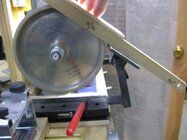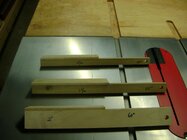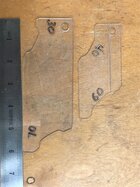-
It's time to cast your vote in the October 2025 Turning Challenge. (click here for details) -
Congratulations to Curt Fuller for "Bell Ornaments" being selected as Turning of the Week for October 27, 2025 (click here for details) -
Welcome new registering member. Your username must be your real First and Last name (for example: John Doe). "Screen names" and "handles" are not allowed and your registration will be deleted if you don't use your real name. Also, do not use all caps nor all lower case.
You are using an out of date browser. It may not display this or other websites correctly.
You should upgrade or use an alternative browser.
You should upgrade or use an alternative browser.
Good Experience - Right Angle Grinding Platform
- Thread starter Tom LeTourneau
- Start date
I have asked Santa for a Right Angle platform. I figure it will eventually pay for itself in the excess steel I don't grind off my skews and scrapers!
My right angle platform is above the centerline of the wheel. I'm using it on a 6" wheel so I adjusted the tilt as Lea suggested. It does every angle that I need. I made a chart with the number and degree so I can adjust it quickly, it was expensive but worth the cost. I am very happy with mine.
Hey Richard, Thanks for the reply. I follow you on Insta, and now Youtube and your video that you liked here is what prompted me to make the purchase.I picked one up at the Symposium in St Paul in June. I’ve been using it since and have been very impressed with it. It’s the plain one rather than the wolverine compatible one as I sharpen freehand. Video Here on my Instagram
Richard
Keep the instructive videos coming, you do a good job with it-- no frills and fancy leads, just good factual hands on tips.
I use these to set platform angle - accurate and home made with scrap wood. Not my idea just saw it on you tube.
you can make them for any angle and as long as on a CBN wheel get the same angle consitantly.
you can make them for any angle and as long as on a CBN wheel get the same angle consitantly.
Attachments
It does matter in the ones I have fabricated:DIY angle finders, work regardless of wheel diameter or platform height. Made from ~0.080” thick sheet plastic from the box store.
As the radius of the wheel changes the thickness needed on the guage board changes. Only works with CBN.
Use this formula r(1-Cos(Deg)) = Thickness of wood needed to achieve the 60 degree platform angle.
Example:
To find 60 degrees platform angle : 8 inch CBN wheel - use this formula r(1-Cos(Deg)) 4(1-Cos(60)) = 2 inches
So as your diameter of the wheel changes it will effect this outcome.
If you had an 8 inch fryable wheel that was ground down to 7 inches the difference would be 3.5(1-Cos(60)) = 1.75 inches
The reason I designed my platform was because I wanted EXACTLY repeatable angles without having to use a jig. There are a number of jig designs for setting angles, and they do work, even as the wheel wears down. However, they don't give you EXACTLY repeatable angle settings. They are "close".
robo hippy
robo hippy
It does matter in the ones I have fabricated:
As the radius of the wheel changes the thickness needed on the guage board changes. Only works with CBN.
Use this formula r(1-Cos(Deg)) = Thickness of wood needed to achieve the 60 degree platform angle.
Example:
To find 60 degrees platform angle : 8 inch CBN wheel - use this formula r(1-Cos(Deg)) 4(1-Cos(60)) = 2 inches
So as your diameter of the wheel changes it will effect this outcome.
If you had an 8 inch fryable wheel that was ground down to 7 inches the difference would be 3.5(1-Cos(60)) = 1.75 inches
I made some templates in this Instagram video without the maths and have used them for a long time on my CBN wheels. They work very well.
Richard
I just want to add that Gil really means it when he says, "I stand behind this product 100%. Any questions or concerns or if you are not fully satisfied with the quality and function, call me."
I did have an issue. I did call Gil. Gil did make it right - and then some! A great product and a great person to do business with!
I did have an issue. I did call Gil. Gil did make it right - and then some! A great product and a great person to do business with!



